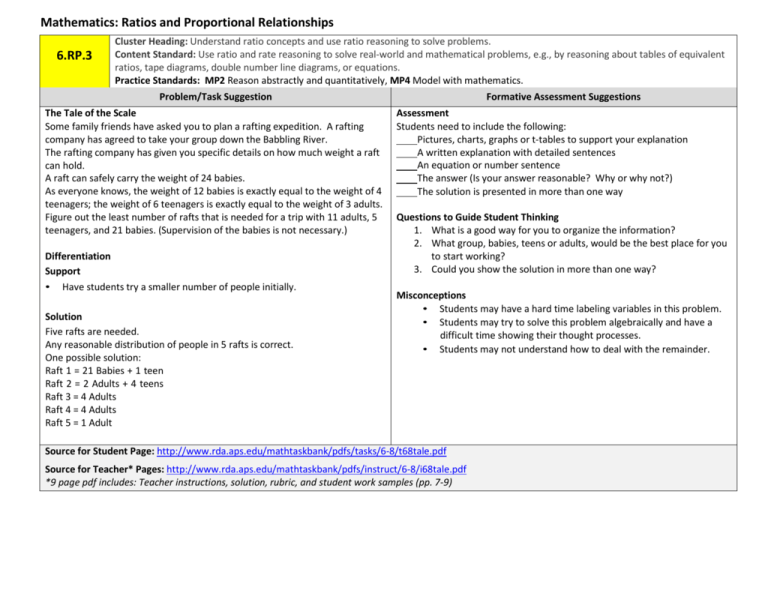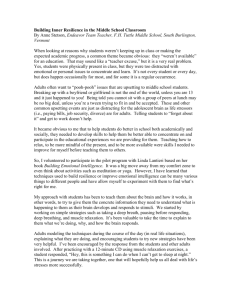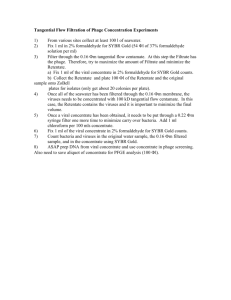6-8 Sample Math Tasks - Illinois State Board of Education
advertisement

Mathematics: Ratios and Proportional Relationships 6.RP.3 Cluster Heading: Understand ratio concepts and use ratio reasoning to solve problems. Content Standard: Use ratio and rate reasoning to solve real-world and mathematical problems, e.g., by reasoning about tables of equivalent ratios, tape diagrams, double number line diagrams, or equations. Practice Standards: MP2 Reason abstractly and quantitatively, MP4 Model with mathematics. Problem/Task Suggestion The Tale of the Scale Some family friends have asked you to plan a rafting expedition. A rafting company has agreed to take your group down the Babbling River. The rafting company has given you specific details on how much weight a raft can hold. A raft can safely carry the weight of 24 babies. As everyone knows, the weight of 12 babies is exactly equal to the weight of 4 teenagers; the weight of 6 teenagers is exactly equal to the weight of 3 adults. Figure out the least number of rafts that is needed for a trip with 11 adults, 5 teenagers, and 21 babies. (Supervision of the babies is not necessary.) Differentiation Support • Have students try a smaller number of people initially. Solution Five rafts are needed. Any reasonable distribution of people in 5 rafts is correct. One possible solution: Raft 1 = 21 Babies + 1 teen Raft 2 = 2 Adults + 4 teens Raft 3 = 4 Adults Raft 4 = 4 Adults Raft 5 = 1 Adult Formative Assessment Suggestions Assessment Students need to include the following: Pictures, charts, graphs or t-tables to support your explanation A written explanation with detailed sentences An equation or number sentence The answer (Is your answer reasonable? Why or why not?) The solution is presented in more than one way Questions to Guide Student Thinking 1. What is a good way for you to organize the information? 2. What group, babies, teens or adults, would be the best place for you to start working? 3. Could you show the solution in more than one way? Misconceptions • Students may have a hard time labeling variables in this problem. • Students may try to solve this problem algebraically and have a difficult time showing their thought processes. • Students may not understand how to deal with the remainder. Source for Student Page: http://www.rda.aps.edu/mathtaskbank/pdfs/tasks/6-8/t68tale.pdf Source for Teacher* Pages: http://www.rda.aps.edu/mathtaskbank/pdfs/instruct/6-8/i68tale.pdf *9 page pdf includes: Teacher instructions, solution, rubric, and student work samples (pp. 7-9) Mathematics: Expressions and Equations 7.EE.1 Cluster Heading: Use properties of operations to generate equivalent expressions. Content Standard: Apply properties of operations as strategies to add, subtract, factor & expand linear expressions with rational coefficients. Practice Standards: MP6 Attend to precision, MP3 Construct viable arguments and critique the reasoning of others. Problem/Task Suggestions Make It true Fill in the blanks below to make the equation true for every value of x. Explain the steps you took, as well as any math properties you used. Compare your answer with a student with a different answer. Explain your reasoning and see if either of you can find a mistake or find common ground. Differentiation Support • Start with review of distribution problems as a warm up. Review equivalent expressions and equality. • Fill in one of the blanks with a number and ask the student only to find out the other missing blank. Extensions • Come up with five other possibilities that will also make this a true statement for any value of x. • Substitute multiple values for x and decide if each yields a true statement. Solutions: Infinite number of correct solutions, e.g., • 5(2𝑥 + 2) − 4 = 10𝑥 + 6 • 2(2𝑥 + 2) − 4 = 10𝑥 + −6𝑥 • 8𝑥 + (2𝑥 + 2) − 4 = 10 + −2 • 3(2x + 2) − 4 = 10x − 4x + 2 Created State of Education Content Area Specialist )−4 = • 0(2xby: + 2Illinois 10xBoard + −10x −4 Formative Assessment Suggestions Observation of Students • Is the student able to recognize what the problem is asking? MP1 • Is the student able to use mental math to do simple computations or does he or she need to use another tool? MP5 • Does the student recognize that different answers are possible? • Can the student explain the process to other students? MP6 • Does the student generate a true equation? • Does the student include a written explanation including precise language? MP6 Questions to Guide Student Thinking • Can you explain your steps in writing and to your group members? MP3 • Simplify each side of the equation and tell me what you get. • Substitute in multiple values for x and see if it yields a true statement. Misconceptions Students may • Incorrectly distribute, e.g., 5(2𝑥 + 2) − 4 = 10𝑥 + −2 or 8𝑥(2𝑥 + 2) − 4 = 10𝑥 − 4 • Incorrectly combine like terms, e.g., 6𝑥 + (2𝑥 + 2) − 4 = 10𝑥 + −4 • Come up with a solution that only works for one value of x, e.g., 10(2𝑥 + 2) − 4 = 10𝑥 + 36 will be true if x = 2. • Think that the same number/expression needs to go in both blanks. Vocabulary Distribute, Expand, Equivalent expressions, Variables, Coefficients Mathematics: Geometry 7.G.6 Cluster Heading: Solve real-life and mathematical problems involving angle measure, area, surface area, and volume. Content Standard: Solve real-world and mathematical problems involving area, volume and surface area of two- and three-dimensional objects composed of triangles, quadrilaterals, polygons, cubes, and right prisms. Practice Standards: MP4 Model with mathematics, MP2 Reason abstractly and quantitatively. Problem/Task Suggestions Formative Assessment Suggestions Fish Tank A rectangular fish tank, 30 cm long and 18 cm wide, is filled with water to a depth of 8 cm. When a brick of unknown size is completely submerged in the water, the water level rose to 11 cm with no water splashing out. Find the volume of the brick. Show all calculations and explain how you got your answer. Observation of Students • Do students know how to calculate the volume of a rectangular prism? • Does the student use precise language? MP6 • Does the student recognize the volume of the water at its new height minus the volume of the water at its original height will yield the volume of the brick? • Is the student able to correctly set up an expression? • Is the student able to explain, to their peers and in writing, how they found the answer? Differentiation Support • Have a tank available to demonstrate the process. • Ask the student to find the volume of the water before and after the brick was dropped and explain the difference. Extension • Ask the student how the problem would be different if the brick was spherical. Solution • 30 x 18 x (11 – 8) = 1620 cm3 by finding the difference in height and calculating the volume using this difference as the height. • (30 x 18 x 11) – (30 x 18 x 8) = 1620 cm3 by finding the volume originally and subtracting from the new volume. Questions to Guide Student Thinking • Could you draw a picture to represent this problem? Show me, on the picture, what volume you calculated. • If two rectangular prisms were put together, how could you find the total volume? If we knew one prism’s volume and the total volume, how could we find the other prism’s volume? • How would the problem change if the brick was not completely submerged? Misconceptions Students may • Multiply the first three numbers (30 x 18 x 8 = 4320cm3 ) • Multiply the three numbers for the final volume (30 x 18 x 11 = 5940cm3) • Multiply all four numbers (30 x 18 x 8 x 11 = 47520cm3) • Say it can’t be found because we don’t know the dimensions of the brick • Forget to label the solution in cubic centimeters Vocabulary Volume, difference, rectangular prism Adapted from: American Institutes for Research, Singapore Textbook Volume Problems, Grade 5 Geometry Strand. Mathematics: Ratios and Proportional Relationships 7.RP.3 Cluster Heading: Analyze proportional relationships and use them to solve real-world and mathematical problems. Content Standard: Use proportional relationships to solve multi-step ratio and percent problems. Practice Standard: MP2 Reason abstractly and quantitatively. Problem/Task Suggestions Grape Juice Jungle: Which Tastes Juicier? If all grape concentrates are the same strength, which recipe would you expect to have the strongest grape taste? 1) Jerry’s Juice: 2 cups concentrate, 3 cups water 2) Grapeade: 5 cups concentrate, 8 cups water 3) Good Grape: 3 cups concentrate, 4 cups water 4) Jane’s Juice: 4 cups concentrate, 7 cups water Work with a partner. Share reasoning and solution strategies on chart paper. Differentiation Support • Provide students with concentrate and juice for the four mixtures. • Have the students compare two mixtures at a time. • Ask students to consider how many cups total are in each mixture. Extension • You have two same-size containers of milk: one is chocolate milk and one is white milk. If you pour 10% of the chocolate milk into the white milk, then pour 10% of the white milk container into the chocolate milk container, is there more chocolate milk in the white milk, or more white milk in the chocolate milk? Show calculations and explain your solution. Solution • One way is to determine how much concentrate each recipe uses for 1 cup of water. The one that uses the most concentrate should have the strongest grape taste. Good Grape has the most concentrate (0.75) for 1 cup of water. It should have the strongest grape taste. • Another way is to find out how much water each recipe uses for 1 cup of concentrate. The recipe that uses the least water will have the strongest grape taste. Good Grape has least amount of water, 1 1/3 cup, to 1 cup concentrate, so it will have the most grape flavor. Adapted from: http://www.figurethis.org/challenges/c25/challenge.htm Formative Assessment Suggestions Observation of Students • Are students able to set up equations relating part to whole or part to part? • Do students recognize higher concentrate has stronger taste? Questions to Guide Student Thinking • What factors influence the grape taste? • How could you set up this problem? • When you are setting up the problem would labels be important? • Does the quantity make a difference? • What would happen if we made juice for the class using the chosen brand? How much concentrate and water would be needed? Misconceptions • Some students may think the juice with the most concentrate has the strongest grape taste without looking at the amount of water. • Some students might add quantities of concentrate and water and decide the largest sum is the correct answer. • Students correctly compute 2÷ 2 3÷ 2 • = 1 but incorrectly interpret the 1.5 answer as 1 part water to 1.5 part concentrate instead of the correct interpretation of 1 part concentrate to 1.5 parts water. Students may not understand what factors contribute to strong grape taste. Vocabulary Concentrate, Ratios, Proportions Mathematics: Expressions and Equations 8.EE.1 Cluster Heading: Work with radicals and integer exponents. Content Standard: Know and apply the properties of integer exponents to generate equivalent expressions. Practice Standards: MP3 Construct viable arguments and critique the reasoning of others, MP6 Attend to precision. Problem/Task Suggestions You are the Teacher A student simplified the exponential expression on the left to get the expression on the right. If the student’s work is correct, explain the steps used to simplify it. If it is incorrect, explain what mistakes were made and the correct simplification. Use appropriate terminology in your explanation. (−2𝑥 3 )4 = −16𝑥7 Differentiation Support • Have the student look at each part of the expression separately (-2)4 (x3)4 Extension • Write an equation that has a common exponential mistake. Share it with another student to see if he/she can find the mistake. Solution • • (−2𝑥3 )4 = 16𝑥12 Explain that the -2, when taken to the fourth power, is positive and that x to the third power, to the fourth power, would be 12 using the Power Property. Created by: Illinois State Board of Education Content Area Specialist Formative Assessment Suggestions Observation of Students • Do students know how to apply the power property of exponents? • Is the student using precise language e.g. Power Property? MP6 • Does the student recognize that there is more than one mistake? • Is the student able to convey their thoughts verbally to other classmates? • Does the student generate the correct simplification? • Does the student explain in words that the power property was used incorrectly? • Does the student recognize that taking a negative number to the fourth power would yield a positive number? Questions to Guide Student Thinking • How could you represent the fourth power? (-2x3)(-2x3)(-2x3)(-2x3) • Review the properties of exponents and decide if you correctly followed them. • Can you show me what happens when you raise (-2) to the second, third and fourth power? What do you notice? Misconceptions Students may • Explain the expressions equal each other because they simplify using −24 𝑥4+3 . • • Recognize one, but not both, mistakes. Believe the coefficient should be 8 or -8 because the -2 and 4 should be multiplied. Vocabulary • Power property, exponent, negative Mathematics: Functions 8.F.4 Cluster Heading: Use functions to model relationships between quantities. Content Standard: Construct a function to model a linear relationship between two quantities. Determine the rate of change and initial value of the function from a description of a relationship from two (x, y) values, including reading these from a table or from a graph. Interpret the rate of change and initial value of a linear function in terms of the situation it models, and in terms of its graph or a table of values. Practice Standards: MP4 Model with mathematics, MP6 Attend to precision. Problem/Task Suggestions Tile Pattern A tile pattern is growing at a constant rate. Below there is information from this tile pattern. Using this information, generate an equation to model this relationship. Describe the pattern in words with enough detail that another student could create this pattern using only your description. Differentiation: Supports Ask the student what point is represented by the figure. Ask the student what the slope is based on the graph. Extensions Show an additional representation of this relationship such as a table. Draw another figure that would be part of this pattern. Solution 𝑦 = 3𝑥 + 4 Explain the pattern’s growth in one of several ways, e.g., the pattern starts with 4 tiles in a diagonal line and adds three tiles to the right side in a vertical line for each figure. Formative Assessment Suggestions Observation of Students Is the student able to locate slope using the change in y and change in x given in the graph? Is the student able to create an ordered pair from a tile representation? Is the student able to communicate a detailed pattern in words to other students and in a written description that could only result in the initial tile pattern and graph? (MP6) Does the student use the point and the slope to create an equation? Questions to Guide Student Thinking What information do you need to write a linear equation? Create a table of values that match your information. What information is given from the tiles, from the graph? How do we find the rate of change from a graph? What must always be true about the y-intercept? Misconceptions Students may Believe the slope is 4 because of the 1 and 3 in the slope triangle. 1 ∆𝑥 Believe the slope to be 3 by calculating∆𝑦. Believe the figure is the initial value, resulting in 𝑦 = 3𝑥 + 13. Believe that the scale of the vertical axis is 1, resulting in an initial value of 1 and the equation 𝑦 = 3𝑥 + 1. Adapted from: Dietiker, L., Kysh, J., Hoey, B., & Sallee, Y. (2006). College Preparatory Mathematics Algebra connections. (3.1 ed.). Sacramento.






